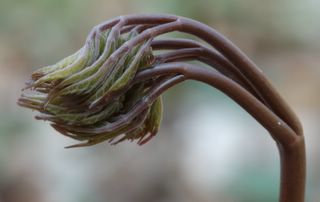Unkown Sprout

Unknown Sprout, April 11, 2005
Here is a perfect example of what got me started doing wildflower photography back in the mid 1980s. I was getting ready to start working on a project in which I would be studying the pollination of spring beauty or Claytonia virginica. But everything was so new to me and I had no idea how to begin. So I started walking through the woods during early spring 1987 and tried to remember as much as I could about which plants were growing in which locations. But there was too much to learn and it was overwhelming, so I started taking snapshots of sprouts beside hand-written labels. Of course the photographs were horrible, but the strategy worked.
Little by little, I became more and more picky about how my photographs should look. The first thing I realized is that I needed to get CLOSER to the subject to fill the frame a little more. I also realized that the hand-written notes did not belong within the frame! I got some diopters (screw-on close-up lens attachments) that helped bring me closer to the subject, though they also made it hard to focus and reduced the clarity of the image. Eventually, I switched to a Cannon AE-1 body and got some better lenses, like a Cannon 50 mm macro lens, and later a Sigma 200 mm macro lens. The 200 mm lens really helped a lot. Then, nearly 5 years ago, prior to my first Rod Planck Photography workshop, I switched to the Nikon N-80 body and got some awesome Nikon lenses. The best lens for me was and remains the Nikon 200 mm micro. As long as I focus it correctly (ha ha) it gives a razor sharp image that can be really close. Eventually, I tried a Tamron 1.4 teleconverter to get even closer!!
Ayway, I believe the plant featured here as the "unknown sprout" is baneberry, but I want to check it one more year before I say for sure. See, baneberry looks a lot like another plant that often grows beside it. When the plants are mature, I can tell the difference pretty easily because one plant has arromatic leaves and the other does not. (I forget which is which, but I think the baneberry is the aromatic one.) See, I rub a leaflet gently between my index finger and thumb, and then I sniff my finger tips. One of the plants leaves behind an interesting aroma that I cannot yet describe. The other plant leaves no aroma at all.
This is part of the process I use when learning about new plants. I use my eyes, fingers, and nose. I can FEEL the texture of a plant when I touch it--like whether it is rubbery, or sticky, or fuzzy, or smooth. Of course, it's lucky that I already know how to identify poison ivy with my eyes! That is one of the few plants, aside from stinging nettle, that I prefer NOT TO TOUCH!!!


0 Comments:
Post a Comment
<< Home